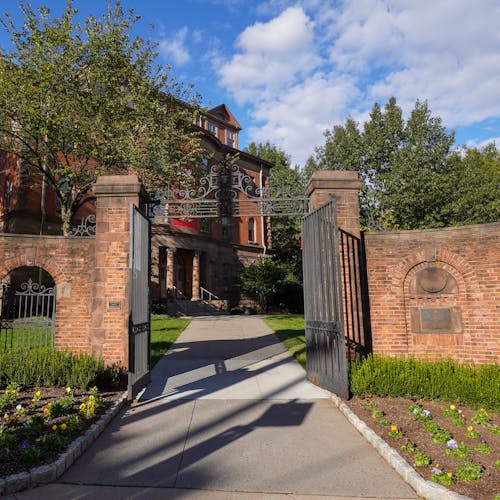EDITORIAL: Rutgers green spaces should serve as model for surrounding neighborhoods
We benefit from dozens of green spaces maintained on Rutgers campus, something we need to share with New Brunswick residents

There is nothing like leaving a stressful (in-person) class in some stuffy Rutgers building and walking across a lawn, park or campus quadrangle to get to your next engagement. The brief walk in crisp air on little paths that bend between the trees fills up your social and emotional battery faster than you would expect. Suddenly, the stress of your coursework does not seem to press down so hard.
Maintaining many green spaces on campus is something that Rutgers does well — really well. Watching the colors change on Voorhees Mall on the College Avenue campus, going on a run in the Livingston Ecological Preserve or visiting Rutgers Farm on Cook campus are just a few examples of green space privileges we enjoy as Rutgers students.
These spaces are spaced out across all five campuses and well maintained, providing students with hang-out spots free of charge.
These green spaces are vital to our mental and physical health as well as the health of the environment surrounding us, but they are not as accessible or widespread off-campus.
While New Brunswick does have 272 acres of beautiful parks complete with gardens and recreational areas, this only represents a little under 8 percent of the 5.23 square miles that make up New Brunswick when it should be about 15 percent, the widely accepted amount of green space in urban areas.
“Green spaces are a necessity, not an amenity,” as once said by Discover Magazine. We treat well-maintained public parks and sidewalks with patches of flowers or trees as a sign of a good neighborhood, as a sign of luxury akin with Whole Foods stores and white picket fences. But green spaces are not decorative — they serve a real environmental, health and social purpose in their communities.
Green spaces significantly affect the environment in any given neighborhood but especially in urban areas. Students living in New Brunswick over the summer can attest to the intense heat waves that are intensified by concrete.
"In summer, surface temperatures can be a staggering 50 degrees Celcius hotter than the surrounding air, and that heat is transferred to the rainwater that drains into our sewers, which in turn raises water temperatures as it is released into streams, rivers and lakes,” according to the Natural History Museum.
Nonetheless, the number of green spaces in New Brunswick and other cities must increase. Introducing more parks and trees into concrete jungles can lower heat, reduce smog and increase carbon sequestration, lowering the amount of carbon released into the atmosphere.
"By increasing the diversity of trees on our streets, we can create miniature forests,” said Dr. Cecil Konijnendijk, a professor in the Department of Urban Forestry at the University of British Columbia. Such solutions are largely self-maintained, cutting down on park maintenance costs. The point is, green spaces are possible, even on a budget.
Dr. Mark Nieuwenhuijsen, director of urban planning, environment and health initiative at ISGlobal, also maintains that green spaces in cities reduce premature mortality, and the research is on his side.
Green spaces in neighborhoods reportedly lower depression, improve sleep, reduce stress and bring about greater levels of happiness. One reason parks and outdoor community spaces are able to dramatically increase the mental and physical health of residents is that they create a shared community space, which is vital.
This increase in social interaction and overall health also has another unexpected result: lowering crime. "Research finds that well-designed and -maintained urban parks can reduce gun violence, improve safety and keep residents healthier, while poorly-designed and -maintained parks lead to more crime," according to Cornell University.
Studies have shown that people of color are three times more likely than white people to live in areas lacking green spaces, and 70 percent of low-income communities lack vegetation.
That said, increasing green spaces in poor neighborhoods rapidly leads to gentrification, something public policy planning must take into account. There have been some initiatives to plant fruit trees in these areas, but more must follow.
Rutgers has taken the initiative to share on-campus green spaces with all New Brunswick residents, including an upcoming walk on Sept. 25.
While we acknowledge that Rutgers cannot replace the New Brunswick Parks & Gardens Commission, the challenge of increasing green spaces in the city provides a unique opportunity for students at Rutgers to get involved in community service projects and a hands-on learning experience.
The Edward J. Bloustein School of Public Policy or the Department of Civil Engineering of the School of Engineering could partner with the city of New Brunswick to come up with real solutions to increase green spaces in the area. It would not be the first time Rutgers professors have stepped up to help communities in need.
A little more than a year ago, Richard Alomar, associate professor in the Department of Landscape Architecture, coordinated a project to help out a Puerto Rican community ravaged by hurricanes. We can help our surrounding communities the same way we reach out to other areas in need. Students can volunteer in local gardens and parks when opportunities arise and become invested in the health of their community.
As Rutgers students, we are lucky to have a few years to explore our campus and take advantage of parks and gardens, hidden between classrooms and dorms. We need to use our first-hand experience with successful green space planning and share it with our neighborhoods and communities, starting with New Brunswick.
The Daily Targum's editorials represent the views of the majority of the 153rd editorial board. Columns, cartoons and letters do not necessarily reflect the views of the Targum Publishing Company or its staff.



